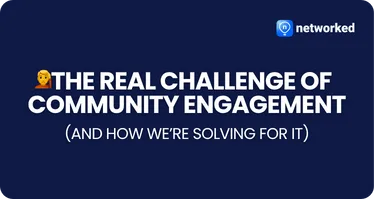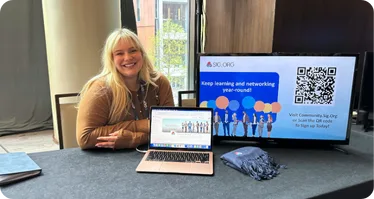Gamification is the process of incorporating game-like elements into non-game environments, such as business operations, marketing strategies, or employee engagement initiatives. Think of it as adding a layer of fun and competition to otherwise mundane tasks. This can include things like point systems, leaderboards, badges, and rewards that motivate people to engage more actively and consistently.
For example, have you ever used a fitness app that gives you badges for hitting your workout goals? Or perhaps you’ve participated in a loyalty program where you earn points for every purchase, eventually redeemable for discounts or freebies. These are all forms of gamification at work.

Why Gamification is Essential for Small Business Communities
Grabbing and holding the attention of customers and employees can be challenging, especially for small businesses competing with larger corporations. This is where gamification comes in. By making interactions more engaging and rewarding, gamification can transform how people connect with your brand.
Here are a few reasons why gamification is essential for small business communities:
👉 Boosts Engagement: Whether it’s your customers or employees, everyone loves a good game. By introducing elements of fun and competition, you can significantly increase engagement levels. This means customers spend more time on your platform, and employees are more motivated to perform their tasks.
👉 Encourages Loyalty: Gamification can turn a one-time buyer into a loyal customer. Through point systems and rewards, you can incentivize repeat purchases and foster a sense of loyalty. Similarly, recognizing and rewarding employees’ achievements can enhance their dedication and reduce turnover.
👉 Enhances Learning and Development: For businesses that require regular training and development, gamification can make this process more enjoyable and effective. Employees are more likely to engage with training programs that include quizzes, challenges, and interactive content.
👉 Fosters Community Building: A strong sense of community can be a game-changer for small businesses. Gamification encourages interaction and collaboration among community members, whether they’re customers sharing their achievements on social media or employees working together to complete a challenge.
👉 Drives Behavioral Change: Gamification taps into basic human psychology, leveraging rewards and recognition to drive desired behaviors. Want your customers to explore more of your products? Offer points for browsing different categories. Need your employees to adopt a new process? Create a leaderboard to track their progress.
The Psychology Behind Gamification
At its core, gamification leverages basic principles of human psychology to motivate and engage people. It taps into our natural desires for reward, achievement, status, and competition. When these elements are woven into non-game contexts, they transform mundane tasks into exciting and engaging activities.
Let’s break down the key psychological concepts that make gamification so effective:
Positive Reinforcement and Competition
Positive Reinforcement: This is a powerful psychological tool that involves rewarding a behavior to encourage its repetition. In gamification, positive reinforcement comes in the form of points, badges, and rewards. When users complete a task, they receive immediate positive feedback, which boosts their motivation to continue.
Example: Think about loyalty programs at coffee shops. Each time you buy a coffee, you get a stamp. Collect ten stamps, and you get a free drink. This simple reward system encourages you to keep coming back for more.
Competition: Humans are inherently competitive. By introducing elements of competition, gamification taps into our desire to outperform others and achieve higher status. Leaderboards, rankings, and contests can create a sense of urgency and drive participants to push themselves harder.
Example: Fitness apps like Strava use leaderboards to show how your performance stacks up against others. This not only motivates you to improve but also fosters a sense of community as you cheer for or challenge your peers.
Fun and Engagement
Fun: One of the most compelling aspects of gamification is the element of fun. By making tasks more enjoyable, gamification reduces the perception of effort and increases overall satisfaction. Fun is a key motivator that keeps users coming back for more, turning routine activities into something they look forward to.
Example: Language learning apps like Duolingo incorporate game-like elements such as streaks, levels, and rewards. This transforms the sometimes tedious process of language learning into an enjoyable and addictive experience.
Engagement: Gamification drives engagement by creating immersive and interactive experiences. When users are actively engaged, they are more likely to invest time and effort into the activity. This leads to higher retention rates and more meaningful interactions.
Example: Online communities that use gamification to encourage participation see higher levels of user engagement. Members are more likely to contribute, share, and collaborate when they are rewarded for their actions.
Benefits of Gamification for Small Businesses
Increased Customer Engagement
Gamification can significantly boost customer engagement by transforming routine interactions into exciting experiences. When customers are engaged, they spend more time on your platform, interact more frequently with your content, and develop a deeper connection with your brand.
Example: Loyalty programs that reward customers with points for every purchase encourage repeat visits and sustained interaction. Customers are motivated to return and engage more with your business to earn more points and achieve rewards.
Enhanced Employee Motivation
For small businesses, keeping employees motivated and productive can be a challenge. Gamification can help by making work tasks more enjoyable and rewarding.
Example: Incorporating leaderboards and rewards for achieving targets can turn routine tasks into engaging competitions. Employees strive to climb the leaderboard and earn recognition, which boosts their motivation and productivity.
Improved Community Building
Gamification fosters a sense of community by encouraging collaboration and interaction among members. This is crucial for small businesses looking to build a loyal customer base or a cohesive team.
Example: Online forums or social media groups that use gamified elements like badges and levels encourage members to contribute more actively. This creates a vibrant, engaged community where members feel valued and connected.
Key Elements of Gamification
Rewards and Recognition
Rewards and recognition are at the heart of gamification. By offering tangible rewards or public acknowledgment, you can incentivize desired behaviors and make participants feel valued.
Example: Implementing a reward system where customers earn discounts or free products after a certain number of purchases encourages ongoing engagement. For employees, recognizing achievements with awards or shout-outs boosts morale and fosters a positive work environment.
Point Systems and Leaderboards
Point systems and leaderboards add a competitive edge to gamification. They provide clear, measurable goals for participants to strive for and a way to track progress.
Example: A fitness app that assigns points for completed workouts and displays a leaderboard of top performers motivates users to stay active and compete with their peers.
Badges and Achievements
Badges and achievements serve as milestones that recognize participants’ progress and accomplishments. They provide a sense of achievement and encourage continued participation.
Example: Language learning platforms that award badges for completing lessons or reaching certain proficiency levels make the learning process more engaging and rewarding.
Quests and Challenges
Quests and challenges introduce a narrative element to gamification, making tasks more engaging by turning them into missions or adventures.
Example: A project management tool that sets up weekly challenges for teams to complete certain tasks can make the work environment more dynamic and goal-oriented. Completing these challenges not only boosts productivity but also strengthens teamwork.
Incorporating these key elements into your business strategy can transform both customer interactions and employee experiences. By making everyday tasks more engaging and rewarding, gamification helps small businesses drive engagement, motivation, and community building, ultimately leading to greater success.
Gamification Strategies for Customer Engagement
Implementing Loyalty Programs
Loyalty programs are one of the most effective ways to keep your customers coming back. By rewarding customers for their repeat business, you not only increase customer retention but also encourage higher spending.
Example: Starbucks’ rewards program allows customers to earn stars with every purchase. These stars can be redeemed for free drinks and food, encouraging customers to frequent Starbucks more often to earn more rewards.
Examples of Successful Loyalty Programs
Successful loyalty programs are those that seamlessly integrate gamification elements to create a fun and rewarding experience for customers.
👉 Sephora Beauty Insider: This program uses a tiered reward system where customers earn points for every purchase. Higher spending leads to higher tiers, which unlock exclusive perks and benefits.
👉 Amazon Prime: Although not a traditional point-based system, Amazon Prime’s membership offers various rewards such as free shipping, exclusive deals, and access to Prime Video. The perceived value keeps customers subscribed and engaged.
Creating Branded Games
Branded games are a creative way to engage customers by offering an entertaining experience that also promotes your products or services. These games can be integrated into your website, app, or social media platforms.
Example: Nike’s Run Club app not only tracks runs but also incorporates challenges and leaderboards, encouraging users to beat their personal records and compete with friends. This keeps users engaged with the Nike brand while promoting a healthy lifestyle.
Case Studies of Effective Branded Games
Real-world examples of branded games can illustrate their potential impact on customer engagement.
👉 M&M’s Eye-Spy Pretzel Campaign: M&M’s created a simple yet addictive game to promote their pretzel-flavored candies. The game, which involved finding a tiny pretzel in a sea of M&M’s, went viral, significantly boosting brand visibility and engagement.
👉 KFC’s Shrimp Attack: In Japan, KFC launched a mobile game called “Shrimp Attack” where players protected their virtual shrimp from enemies. The game was highly engaging and drove traffic to KFC’s online platforms, increasing sales and brand loyalty.
Encouraging Social Sharing and Competition
Social sharing and competition can amplify the effects of your gamification efforts. By creating opportunities for customers to share their achievements and compete with others, you foster a sense of community and increase organic reach.
Example: Duolingo encourages users to share their progress on social media and compete with friends in weekly leaderboards. This not only keeps users engaged but also attracts new users through word-of-mouth and social proof.
Gamification Techniques for Employee Engagement
Incorporating Gamification into Training Programs
Training programs can often be dry and monotonous. Gamification can transform these programs into interactive and enjoyable experiences, enhancing learning and retention.
Example: Salesforce’s Trailhead platform uses gamification to teach users about their products. By completing modules and earning badges, employees and customers alike can advance through the training in a fun and engaging way.
Setting Up Team Competitions
Team competitions can foster collaboration and a healthy competitive spirit among employees. These competitions can be based on performance metrics, project completion, or other work-related tasks.
Example: A sales team might compete to see who can achieve the highest sales in a month, with the winner receiving a prize. This not only motivates individual performance but also drives overall team success.
Recognizing and Rewarding Achievements
Recognition and rewards are powerful motivators. By acknowledging employees’ hard work and achievements, you can boost morale and encourage continued high performance.
Example: Implementing an employee of the month program where top performers are publicly recognized and rewarded with bonuses, gift cards, or extra time off can significantly enhance motivation and job satisfaction.
Using Gamified Project Management Tools
Project management tools that incorporate gamification can make managing tasks and deadlines more engaging. These tools can include features like progress tracking, milestone celebrations, and team leaderboards.
Example: Asana and Trello are project management tools that offer gamified features such as progress bars and achievement badges. These elements help teams stay motivated and focused on their goals.
Best Practices for Implementing Gamification
Understanding Your Audience
Before diving into gamification, it’s crucial to understand who your audience is and what motivates them. This means segmenting your customers and employees to tailor the gamification elements to their preferences and behaviors.
Example: Younger customers might respond well to social sharing and competition, while older customers might prefer rewards and recognition. Conduct surveys or use analytics tools to gather insights into your audience’s preferences.
Setting Clear Goals and Objectives
Define what you want to achieve with your gamification strategy. Clear goals and objectives will guide your design and implementation, ensuring that your efforts align with your business needs.
Example: If your goal is to increase customer retention, your gamification strategy might focus on loyalty programs and repeat engagement. For employee productivity, consider leaderboards and performance-based rewards.
Keeping It Simple and Intuitive
Gamification should enhance the user experience, not complicate it. Ensure that the game mechanics are easy to understand and intuitive to use. Overly complex systems can deter engagement and frustrate users.
Example: A simple point system with clear rules and visible progress is more effective than a convoluted scheme with hidden criteria. Test your gamification elements with a small group first to iron out any complexities.
Continuously Monitoring and Refining Your Approach
Gamification is not a set-it-and-forget-it strategy. Regularly monitor its performance and gather feedback to identify what’s working and what’s not. Be prepared to make adjustments to improve the effectiveness of your gamification efforts.
Example: Use analytics to track participation rates, engagement levels, and overall satisfaction. If a particular element is underperforming, tweak it or try a different approach. Solicit feedback directly from your users to gain insights into their experiences.
Challenges and Considerations
While gamification can be highly effective, overdoing it can lead to diminishing returns and even negative outcomes. Too many game elements can overwhelm users and make the experience feel forced or inauthentic.
Example: Instead of adding gamification elements to every aspect of your business, focus on areas where they will have the most impact, such as customer loyalty programs or employee training modules.
Balancing Fun and Professionalism
It’s important to strike a balance between making activities fun and maintaining a professional atmosphere. Overly playful elements might detract from your brand’s image or make serious tasks seem trivial.
Example: A financial services firm might use subtle gamification elements like progress bars and badges, avoiding overly playful graphics or language that could undermine their professional credibility.
Ensuring Fairness and Inclusivity
Gamification should be fair and inclusive, ensuring that all participants have an equal opportunity to succeed. Avoid designing systems that favor certain groups over others or create undue pressure.
Example: Ensure that rewards and recognition are based on clear, achievable criteria. Avoid competitions that could foster unhealthy rivalry or exclude less competitive participants. Provide multiple ways for users to earn rewards, catering to different strengths and preferences.
Tools and Platforms for Gamification
👉 Badgeville: A comprehensive platform that offers a variety of gamification tools, including badges, leaderboards, and social sharing features.
👉 Bunchball: Known for its robust analytics and flexible gamification elements, suitable for both customer and employee engagement.
👉 Kahoot!: Popular for educational and training purposes, Kahoot! uses quizzes and interactive games to enhance learning.
👉 Salesforce’s Trailhead: An excellent tool for employee training and development, with interactive modules and reward systems.
Criteria for Selecting the Right Tool for Your Business
- Ease of Integration: Ensure the tool can be easily integrated with your existing systems and platforms.
- Customization: Look for tools that allow you to tailor the gamification elements to your specific needs and brand identity.
- User Experience: Choose a tool with an intuitive interface that is easy for both customers and employees to navigate.
Analytics and Reporting: Effective gamification tools should provide robust analytics to track engagement and measure the success of your initiatives. - Scalability: Select a platform that can grow with your business, allowing you to add new features and expand your gamification efforts over time.
Future Trends in Gamification
👉 Artificial Intelligence (AI): AI can personalize gamification experiences by analyzing user behavior and tailoring rewards and challenges to individual preferences.
👉 Virtual and Augmented Reality (VR/AR): These technologies can create immersive gamified experiences, particularly in training and customer engagement.
👉 Blockchain: Blockchain technology can add transparency and security to gamification, particularly in tracking rewards and achievements.
Predictions for the Future of Gamification in Small Businesses
👉 Increased Personalization: Future gamification strategies will be highly personalized, using data and AI to create unique experiences for each user.
👉 Greater Integration with Social Media: Social sharing will become even more integral to gamification, with more opportunities for users to share achievements and compete with friends.
👉 Focus on Sustainability and Social Impact: Gamification will increasingly be used to promote sustainable practices and social responsibility, aligning business goals with broader societal values.
Conclusion
Gamification can revolutionize both customer and employee engagement by making everyday tasks more enjoyable and rewarding. It boosts customer loyalty, enhances employee motivation, and fosters a strong sense of community.
Begin with simple gamification elements that are easy to implement and measure. As you see positive results, gradually expand your gamification efforts to include more complex and integrated systems.
Networked provides a seamless environment where you can implement these gamification strategies effectively, helping you to grow and sustain a dynamic and loyal community. Sign up today, by clicking here.




